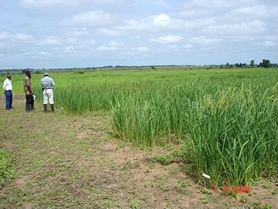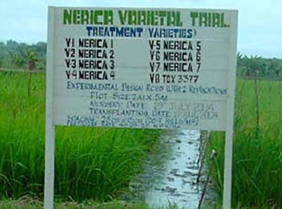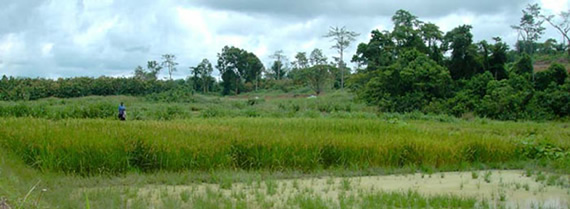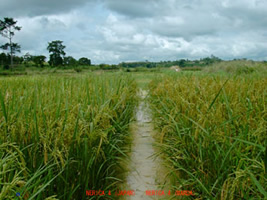|
|
In 2004, 7 NERICA varieties with two seed sources,
Africa Rice Center
(WARDA) and Japan, were planted at three locations (Table 1). Dates and methods of planting, as well as the level of fertilizers, were different. At
Savanna Agriculture Researh
Institute (SARI) (Photo 1), irrigation was not available and direct hill seeding was adopted, and later thinned so as to comprise 1 plant only per hill. At
Crops Research
Institute (CRI) (Photo 2) and Ghana Irrigation Development
Authority (GIDA) (Photo 3), Ashaiman, single 3 week-seedling was transplanted to each hill. Level of fertilizer application was greatly different between the two sites. At CRI, each variety of two seed sources were planted side by side, while the other two sites adopted the split plot design with the seed source as the main plot, and varieties as subplots. The primary purpose of the trial was to secure good seeds for the next season, and characteristics were checked in due course, as basically proposed by Mr.
Tsuboi.
|

(Photo
1) SARI |
|

(Photo
3) GIDA |
|

(Photo 2)
CRI |
NERICA6 seems to be rather stable in the days to flowering comparing to other varieties, which was noticed in Japan in three year trial. In Ghana, this tendency was also noticed, and NERICA1 seemed to reach the heading stage later in site of higher latitude. Difference of heading was not observed between the two seed sources.
As for the plant type, all of NERICA varieties can be classified as low tillering/panicle weight type. Especially NERICA6 is the tallest, with the culm length of 117 cm at the CRI test site, almost equal to the check variety TOX3377-34-3-3-7. However, none of NERICAs at CRI field (with higher fertilizer application) lodged.
Irrigation and fertilizers usually affect number of tillers. However, in case of NERICA varieties this is not true, but the data from CRI indicate that panicle length and number of grains per panicle are remarkably increased when compared with data from SARI and GIDA. Increased grain number tends to reduce the percentage of filled grains, but data from SARI and GIDA indicates that low levels of fertilization affected lower grain filling percentage, resulting in lower yield. The reason, why grain filling at GIDA with sufficient irrigation water was as low as that at SARI without irrigation, is to be studied further.
The highest yield calculated from plot harvesting at SARI recorded 6.3 t/ha for the check variety Digang, but the yield calculated from yield components was 3.7 t/ha, which was almost equal with NERICA6. The field conditions at SARI clearly showed that the dry upland conditions are not well adapted to NERICAs, and hydromorphic conditions are more preferable.At CRI, NERICA6 and NERICA2 gave the highest yield of 7.7 t/ha from plot harvesting when the check variety IDSA85 produced 6.2 t/ha. When calculated from the yield components, the two varieties gave 6.5 and 5.8 t/ha, respectively, while IDSA85 yielded 4.8 t/ha. In spite of availability of irrigation water, yields at GIDA was not higher than at SARI. It seems that the merit of irrigation at GIDA was greatly reduced by low level of fertilizer application.
|
Most of NERICA varieties seemed to be insufficient in the uniformity of characteristics. Comparing the two seed sources, offtype plants were more noticed in WARDA populations. NERICA5, -6 and -7 were considered that they are still under the state of segregation in plant height. In case of NERICA4, plot of WARDA seed source was different in the plant height, flag leaf habit and apiculus/hull color (Photo
4). |

(Photo
4) |
At CRI, much attention was paid to securing seeds as pure as possible, and the test field was prepared after killing weeds and plants of the previous cropping by tillage and herbicides. Also, empty spaces were placed between each test plot, and also enough land spaces surrounding the test field. Seeds were harvested separately for the central area and surrounding plants. This type of precautions will be needed to get good seed lots.
[End]
* The project was funded by the
Ministry of Agriculture, Forestry and Fisheries,
Japan.
Papaer originally presented at the JICA Technical Seminar on Rice Cooperation in East & Southern Africa, held on Feb. 17 - 18, 2005, in Nairobi, Kenya, and then some small corrections were made. |